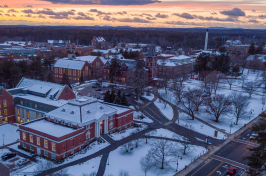The University of New Hampshire is a flagship research university that inspires innovation and transforms lives in our state, nation and world. More than 16,000 students from all 50 states and 71 countries engage with an award-winning faculty in top ranked programs in business, engineering, law, health and human services, liberal arts and the sciences across more than 200 programs of study. UNH’s research portfolio includes partnerships with NASA, NOAA, NSF and NIH, receiving more than $100 million in competitive external funding every year to further explore and define the frontiers of land, sea and space.
UNH Research Finds White Deaths Exceed Births in One-Third of U.S. States
DURHAM, N.H. – More whites died than were born in a record high 17 states in 2014 compared to just four in 2004, according to new research from the Carsey School of Public Policy at the University of New Hampshire. Some 121 million people representing 38 percent of the U.S. population reside in these states: California, Pennsylvania, Florida, Arizona, Massachusetts, New Jersey, New Hampshire, Mississippi, Arkansas, Delaware, Nevada, Maine, Alabama, Connecticut, New Mexico, West Virginia and Rhode Island.
The research found that non-Hispanic white deaths now exceed births in a growing number of states because more whites are dying and fewer white babies are being born. These demographic changes in the white population result from a rising number of older adults, fewer women of childbearing age and lower fertility rates. Because these trends are difficult to reverse many of these states are likely to see white deaths continue to exceed births.
As white population increase has diminished it has been offset by minority population gains, the researchers found. In particular, births exceed deaths by a considerable margin among the Latino population because it is younger, has a larger proportion of women of childbearing age and higher fertility rates. The combination of these demographic trends is increasing the diversity of the U.S. population. According to Census Bureau projections, whites will make up less than half of the U.S. population (47 percent) by 2050. In contrast, the youthful Latino population is projected to be 29 percent of the U.S. population by 2060.
“These demographic trends have major policy implications,” the researchers said. “The largely white older population will grow rapidly as baby boomers continue to age, increasing demands on the healthcare and retirement systems. In addition, the youthful minority population will require major investments in education and training if the U.S. is to maintain a productive workforce in an increasingly competitive technological and global labor market. The competing demands will create considerable potential for disagreements regarding funding priorities.”
The full report can be found here: https://carsey.unh.edu/publication/white-deaths
The research was conducted by Kenneth Johnson, senior demographer at Carsey and a professor of sociology at UNH, and Rogelio Sáenz, policy fellow at the Carsey School and dean of the College of Public Policy and Mark G. Yudof Endowed Professor at the University of Texas at San Antonio.
The Carsey School of Public Policy conducts research, leadership development, and engaged scholarship relevant to public policy. They address pressing challenges, striving for innovative, responsive, and equitable solutions at all levels of government and in the for-profit and nonprofit sectors.
Latest News
-
December 12, 2024
-
December 11, 2024
-
November 22, 2024
-
November 7, 2024
-
October 30, 2024
















































